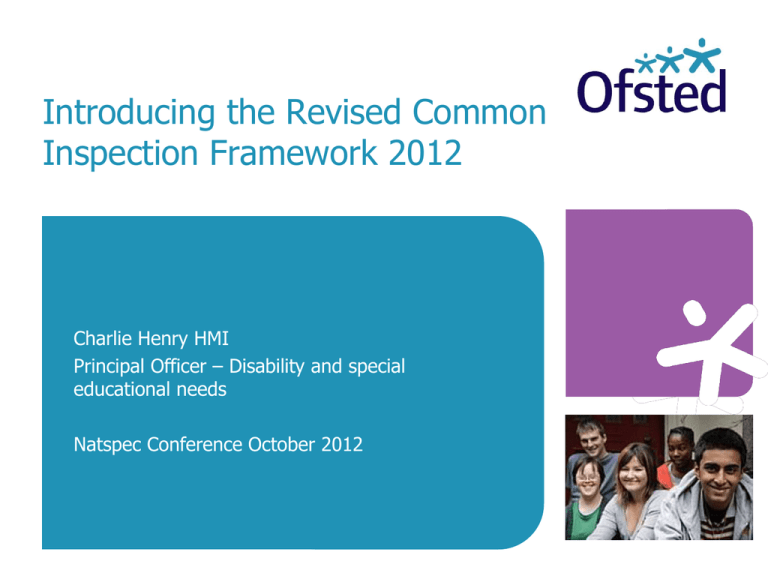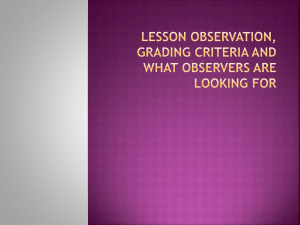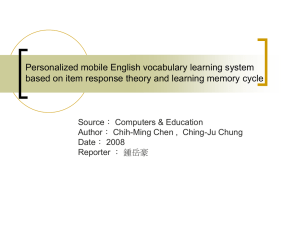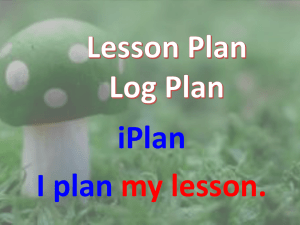Common Inspection Framework 2012 - The Association of National
advertisement

Introducing the Revised Common Inspection Framework 2012 Charlie Henry HMI Principal Officer – Disability and special educational needs Natspec Conference October 2012 Consultation‘A good education for all’ Consultation‘A good education for all’ outstanding providers must have outstanding teaching and learning ‘requires improvement’ replaces ‘satisfactory’ summary of performance management outcomes early inspection for those who are ‘satisfactory’ limit the opportunity to be graded as ‘requires improvement’ to two consecutive occasions ‘no notice’ inspection The Common Inspection Framework 2012 Handbook Part One Conducting inspections Part Two The evaluation schedule’ Independent specialist colleges’ previous inspection record Judgement Next inspection Outstanding and Good Within 6 years of the last inspection Satisfactory preSept 2012 Within 2 years of September 2012 Requires improvement Within 12-18 months Inadequate Re-inspection monitoring visit within 6-8 months of the last inspection, and a full re-inspection within 12-15 months of the last full inspection Types of inspection Inspection – to inspect the provider’s government-funded provision against all aspects of the Common Inspection Framework 2012. Survey report visits – To explore a specific aspect of a provider’s work as part of a programme of surveys based on topics linked to national priorities. Such visits may be added to a routine inspection. Re-inspection Risk assessment – annually Monitoring visits – to be used by exception only Interim assessment – no longer carried out We will continue to: focus on the things that have most impact on improving outcomes for learners – teaching, learning and assessment take account of providers’ self assessment listen to the views of learners, employers, staff and, where appropriate, parents make clear recommendations for the provider’s improvement continue to focus inspections on the weaker providers involve a senior member of staff in the inspection process What is different in the revised framework ? We will: only grade providers as outstanding if they have outstanding teaching and learning replace satisfactory with ‘requires improvement’ focus more on performance management and governance inspect early those who are ‘satisfactory’ limit the opportunity to be graded as ‘requires improvement’ to two consecutive occasions give two days notice of inspection use information provided through ‘Learner view’ We will continue to: undertake an annual risk assessment of all providers have a strong focus on equality and diversity, which will be embedded throughout the framework consider capacity to improve, but within the context of leadership and management. take account of the management of safeguarding arrangements to ensure all learners are safe Aims of the revised framework The revised Common Inspection Framework streamlines and simplifies the existing CIF by focusing on: the aspects of a provider’s work that have most impact on learners reducing the number of judgements and grades the impact of leadership on the learner experience Common Inspection Framework 2012 Overall effectiveness Outcomes for learners Quality of teaching, learning and assessment Effectiveness of leadership and management The common grading scale for all inspection judgements A common grading scale is used in making judgements for organisational inspections: Grade Grade Grade Grade 1 2 3 4 outstanding good requires improvement inadequate What is different in the revised framework ? the emphasis on teaching, learning and assessment the extent to which the provision meets local and national needs increased observation of teaching, learning, skills development and assessment success, rates of progress and progression of different groups of learners destinations - into employment and higher level qualifications no limiting grades for equality and diversity and safeguarding What is different in the revised framework ? We will: only grade providers as outstanding if they have outstanding teaching and learning replace satisfactory with ‘requires improvement’ focus more on performance management and governance inspect early those who are ‘satisfactory’ limit the opportunity to be graded as ‘requires improvement’ to two consecutive occasions give two days notice of inspection use information provided through ‘Learner view’ Overall Effectiveness Inspectors will finally judge the quality of education and/or training provided - taking account of: the three key aspect judgements the extent to which the education and/or training meets the needs of the range of learners at the provider and, in particular, the needs of learners with learning difficulties and/or disabilities. Note: In judging overall effectiveness, inspectors will take account of the full range of evidence and will then decide whether the provider’s overall effectiveness is outstanding, is good, requires improvement or is inadequate. Myth - Will the two key grades for ‘Outcomes for learners’ and ‘Teaching, learning and assessment’ become the new ‘limiting’ grades? Surely it will be impossible to be judged outstanding? We are confident providers will be found to be outstanding. Providers will only be judged outstanding for ‘overall effectiveness’ if ‘the quality of teaching, learning and assessment’ is judged to be outstanding. We would expect that this high quality teaching, learning and assessment would result in high success rates and very good and sustained progress for learners. However if ‘outcomes for learners’ is not judged to be outstanding this will not necessarily ‘limit’ the overall effectiveness grade. Outcomes for learners Outcomes for learners To judge outcomes for learners we will give particular attention to how well: all learners achieve and make progress relative to their starting points and learning goals achievement gaps are narrowing between different groups of learners learners develop personal, social, and employability skills learners progress to courses leading to higher-level qualifications and into jobs that meet local and national needs Myth - I have heard that ‘Outcomes for learners’ judgement is based purely on success rates data and a comparison with national averages. Is this true? This is not true. None of the judgements are based on data alone. Although inspectors will look at success rate data they will also look at retention, progress, and whether learners go on to do further learning or in to sustainable employment. Inspectors will also talk to learners about whether they enjoy their course and whether it is meeting their needs. Teaching, learning and assessment Teaching, learning and assessment In judging teaching, learning and assessment, inspectors will evaluate the extent to which: learners benefit from high expectations, engagement, care, support and motivation from staff staff use their skills and expertise to plan and deliver teaching, learning and support to meet each learner’s needs staff initially assess learners’ starting points and monitor their progress, set challenging tasks, and build on and extend learning for all learners learners understand how to improve as a result of frequent, detailed and accurate feedback from staff following assessment of their learning Teaching, learning and assessment In judging teaching, learning and assessment, inspectors will evaluate the extent to which: teaching and learning develop English, mathematics and functional skills, and support the achievement of learning goals and career aims appropriate and timely information, advice and guidance supports learning effectively equality and diversity are promoted through teaching and learning. How we will inspect teaching, learning and assessment Inspectors will capture evidence from a variety of learning activities, for example through: direct observation; accompanying an assessor to a number of employers to observe learners’ skills development on the job. They may assess how the learner is progressing compared with their starting point. evaluation of learning materials and their use by learners; the use of technology to deliver and assess learning; examining what learners can do and make as a result of their learning. Myth - I think we are due an inspection shortly. Do I need to have a lesson plan for the inspector? No. You should do what your provision normally expects you to do when planning lessons. One of the greatest advantages of short notice inspections is that there will be no special preparation for inspection. Whatever you do normally in your college will prevail Myth - Inspectors only judge the quality of teaching and learning through at least a series of 30 minute plus observations? Inspectors make judgements on the quality of teaching, learning and assessment by collecting evidence in a number of different ways, including visits to workplaces, lessons, training and assessment sessions to evaluate the impact of the teaching on how well people learn When inspectors observe teachers and trainers the judgement contributes to the inspection team’s evaluation of the quality of teaching overall Inspectors judge the quality of teaching and the learning taking place and not the quality of the teacher Observations contribute to the judgment on teaching, learning and assessment. Taking into account how well learners are assessed, and how this helps them to improve Myth - I have heard that providers need to have a certain proportion of learning sessions observed during the inspection as ‘outstanding’ before the provider can be judged ‘outstanding’. Is this correct? This is incorrect. Ofsted has not established a required proportion of lessons or training sessions that need to be judged outstanding. Inspectors do not observe all sessions during the inspection and when they do visit they may only stay for part of the session. Clearly, it would be unusual for an outstanding’ provider to not have any ‘outstanding’ lessons or training session observations during an inspection but it is worth stressing that a wide range of evidence drawn from across the college is used in conjunction with lesson observations to determine whether the college is outstanding or not. Leadership and Management Leadership and management We will evaluate the extent to which leaders and managers, including, where relevant, governors: demonstrate an ambitious vision, have high expectations for what all learners can achieve, and attain high standards of quality and performance improve teaching and learning through rigorous performance management and appropriate professional development evaluate the quality of the provision through robust selfassessment, taking account of users’ views, and use the findings to promote and develop capacity for sustainable improvement Leadership and management We will evaluate the extent to which leaders and managers, including, where relevant, governors: successfully plan, establish and manage the curriculum and learning programmes to meet the needs and interests of learners, employers and the local and national community actively promote equality and diversity, tackle bullying and discrimination, and narrow the achievement gap safeguard all learners Myth - Will my provision be downgraded if I do not have an up to date self-assessment report? There is no contractual requirement for further education and skills providers to complete a self-assessment report. However, there is an expectation from both Ofsted and the funding bodies that providers will rigorously assess their own performance. When we notify a provider of their inspection the lead inspector will ask for their most recent self-assessment report, in whatever format the provider has chosen to use. Inspectors will want to analyse the impact of the selfassessment processes as part of their evaluation of leadership and management. Inspectors will be critical of providers that do not establish accurate and robust selfassessment processes and/or do not regularly share this information with the governing body, where appropriate. ‘Learner view’ Learners’ views remain an essential component inspection. From Sept 2012, inspectors will use Ofsted’s new web tool – ‘Learner View’ to collect the information they need. Questionnaires will be open all year round. During this inspection period there will be a ‘free text’ box to enter comments. Strong support during consultation particularly the NUS and other learner, employer and parent groups. Providers will be requested to inform their learners of the opportunity to complete the questionnaire by the end of the second day of inspection. How will we use the results? results will feed into the annual risk assessment, alongside other evidence, to help to decide which providers to inspect and when inspectors will view and analyse the latest results during the inspection comments will inform inspection trails by sharing their views, learners, employers, parents and carers will be helping their provider to improve Responses for this provider: 57 10/10/2012 Questionnaires for parents/carers and employers not visible to the general public – users can only access the questionnaires using a link they will receive from their provider no free text questions open all year round including at the point of inspection results not published, but will be discussed with providers during inspections results available to inspectors Inspection report format The front page of the inspection report will include a new short section called ‘Summary of key findings’. The inspection report will: explain in straightforward language what the provider is doing well and what it needs to improve make recommendations The report will be published on Ofsted’s website approximately 25 working days after the inspection has finished. Inspection report format Inner City College – General Further Education College Inspection dates Overall effectiveness 12 – 16 November 2012 This inspection: Requires improvement Previous inspection: 3 Good 2 Outcomes for learners Requires improvement 3 Quality of teaching, learning and assessment Requires improvement 3 Leadership and management Requires improvement 3 Summary of key findings for learners This provider requires improvement because: Generally, the proportion of students, including apprentices, who achieve qualifications across the college provision is average and on many learning programmes and courses the proportion achieving qualifications is too low. Students and apprentices make insufficient progress on many learning programmes and courses compared with their starting points. Progression to higher level qualifications is too low. Some students are following courses which do not suit their needs. The quality of teaching, learning and assessment is too variable in many subject areas and much is not good enough. Teaching is poor on courses where success rates are low. Performance management processes on the college main site provision need improvement, subcontracted performance management of provision is weak. This provider has the following strengths: The college is highly inclusive and plays a major role in providing opportunities for young people and in improving the lives of local people with few or no qualifications and helping unemployed people into work. Few other opportunities exist for these students in the local area. Students enjoy the respectful and tolerant atmosphere at the college. Teachers are successful at improving students’ language and personal skills on ESOL courses and technical skills on arts, media and publishing and hospitality courses. The college has been effective in improving the performance of students of Bangladeshi heritage. Students benefit from excellent accommodation and high quality resources in most vocational areas. Preparing for an inspection Before inspection provider receives a telephone call, by 10:30, two days before the inspectors arrive on site, followed by an e-mail with an attached notification letter lead inspector telephones the provider by 12:00 noon to confirm arrangements and start the inspection process during this telephone call the lead inspector and provider will agree a time for the planning meeting to go ahead. the lead inspector will confirm the range of documents that will be required for the inspection The nominee role remains the same, but increased preparedness will be essential in readiness for a shorter notification period training for nominees is offered at specially focused ‘preparation for inspection events’, details of which can be found at: http://www.excellencegateway.org.uk/node/18970 Preparing for shorter notice Means notification of inspection two working days prior to inspection consider training more than one nominee have a pack available of key data and information have an update of the latest self assessment upload the self assessment the range of provision and venues the number and type of learners subcontractors Questions






